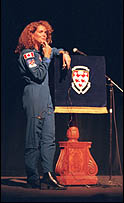Packed house for Payette
| Last week, astronaut Julie Payette returned to her alma mater to talk about the wonders of space travel. The second Canadian woman to travel to outer space, Payette talked about her experiences last May orbiting the Earth in the space shuttle Discovery.
 PHOTO: OWEN EGAN
PHOTO: OWEN EGAN
| |
The journey to outer space was so amazing, she told an audience that packed Moyse Hall, that she'd be hard-pressed to pick a favourite moment. "After such an incredible experience," she said, with a touch of a Houston twang she's picked up working with NASA in Texas, "how could I possibly choose one specific thing?"
However, she added, space's lack of gravity was an awesomely freeing feeling and one that forces humans to think differently.
"We have what I call terrestrial reflexes," she said. "When something falls, we look down. We don't ever think of looking up — not even in space."
During her time in space, she circled the Earth 158 times or once every 90 minutes. "Every day we would see 16 sunrises and 16 sunsets," she recalled, adding the shuttle takes only nine minutes to cross Canada and the spacecraft lifted from the Earth at an astonishing 28,000 km per hour.
At the same time, she pondered, space travel allows people to see how fragile our planet really is. "Because 80 km of atmosphere is the only thing that stands between oblivion and life," she said.
While Payette may be one of the select group of Canadians to travel beyond our earthly borders, she said our country has been involved in space travel since the first moon missions.
She surprised her audience by stating that American feet, specifically astronaut Neil Armstrong, were not the first to touch the moon's surface during NASA's first landing in 1969.
"If you want to be technically correct, the first feet to touch the moon were Canadian," she chuckled, placing her hands on the sides of her electric-blue NASA jumpsuit, noting the first rocket module to land on the moon had Quebec-made feet.
Payette said part of her 10-day space mission was to bring 3.7 tonnes of equipment to the MIR space station. That equipment included everything from water to clothing for the first contingent of astronauts that will soon spend four months on MIR if its third module arrives this summer.
When MIR is finally completed, Payette said, the space station will be the size of two football fields, with most of it composed of solar power panels.
"MIR is the most challenging engineering project in the history of mankind," she said. "Trying to build a station in outer space is comparable to trying to build a ship in the ocean, during a storm, with nine countries helping out."
The MIR space station, Payette said, has marked a new era in space travel, where Russia and the United States are no longer fighting for space supremacy. Now working together, along with seven other countries including Canada, the nine states are quickening the progress of space travel. "The only way we're going to make it to Mars and beyond," she said, "is through international collaboration."
That newfangled cooperation, Payette said, was exemplified on her own mission, where co-astronauts included two former U.S. military men and a Russian colonel. Seeing these soldiers, once trained to fight each other, working together, she said, "is a reflection of the times and a nice way to enter the new millennium."
Moving on to questions from her audience, Payette said she fully expected one query when it came: How do astronauts use the toilet in space? "You aim," she said, explaining that the shuttle is equipped with a suction toilet and that astronauts are given space toilet training, too. "Because there are things you just don't want floating around in space."
Asked if astronauts had ever had sex in space, Payette was almost at a loss for words. "As far as I know, nobody has," she said, noting however that "creatures" brought along for experiments have. "It's one of the fundamentals of research," she said, adding that humans "aren't there yet."

